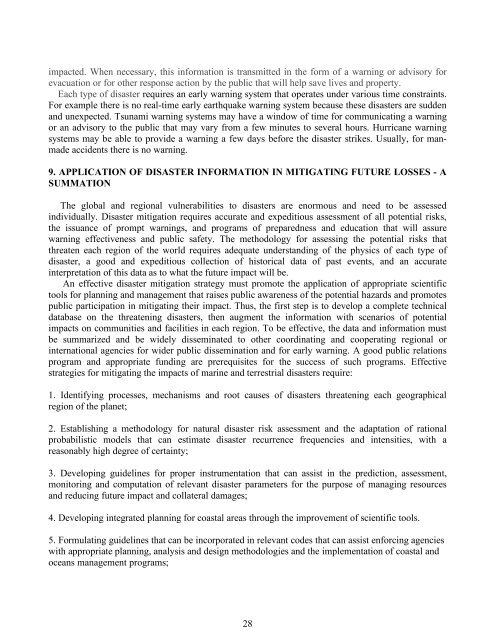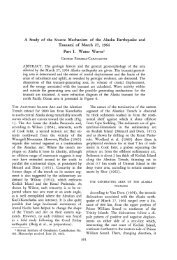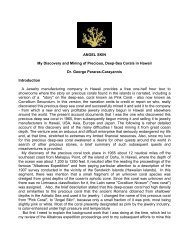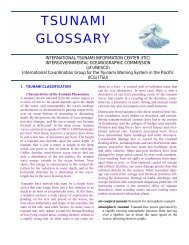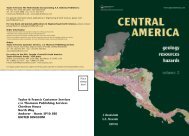vulnerabilities - strategies for mitigating impacts - Disaster Pages of ...
vulnerabilities - strategies for mitigating impacts - Disaster Pages of ...
vulnerabilities - strategies for mitigating impacts - Disaster Pages of ...
Create successful ePaper yourself
Turn your PDF publications into a flip-book with our unique Google optimized e-Paper software.
impacted. When necessary, this in<strong>for</strong>mation is transmitted in the <strong>for</strong>m <strong>of</strong> a warning or advisory <strong>for</strong><br />
evacuation or <strong>for</strong> other response action by the public that will help save lives and property.<br />
Each type <strong>of</strong> disaster requires an early warning system that operates under various time constraints.<br />
For example there is no real-time early earthquake warning system because these disasters are sudden<br />
and unexpected. Tsunami warning systems may have a window <strong>of</strong> time <strong>for</strong> communicating a warning<br />
or an advisory to the public that may vary from a few minutes to several hours. Hurricane warning<br />
systems may be able to provide a warning a few days be<strong>for</strong>e the disaster strikes. Usually, <strong>for</strong> manmade<br />
accidents there is no warning.<br />
9. APPLICATION OF DISASTER INFORMATION IN MITIGATING FUTURE LOSSES - A<br />
SUMMATION<br />
The global and regional <strong>vulnerabilities</strong> to disasters are enormous and need to be assessed<br />
individually. <strong>Disaster</strong> mitigation requires accurate and expeditious assessment <strong>of</strong> all potential risks,<br />
the issuance <strong>of</strong> prompt warnings, and programs <strong>of</strong> preparedness and education that will assure<br />
warning effectiveness and public safety. The methodology <strong>for</strong> assessing the potential risks that<br />
threaten each region <strong>of</strong> the world requires adequate understanding <strong>of</strong> the physics <strong>of</strong> each type <strong>of</strong><br />
disaster, a good and expeditious collection <strong>of</strong> historical data <strong>of</strong> past events, and an accurate<br />
interpretation <strong>of</strong> this data as to what the future impact will be.<br />
An effective disaster mitigation strategy must promote the application <strong>of</strong> appropriate scientific<br />
tools <strong>for</strong> planning and management that raises public awareness <strong>of</strong> the potential hazards and promotes<br />
public participation in <strong>mitigating</strong> their impact. Thus, the first step is to develop a complete technical<br />
database on the threatening disasters, then augment the in<strong>for</strong>mation with scenarios <strong>of</strong> potential<br />
<strong>impacts</strong> on communities and facilities in each region. To be effective, the data and in<strong>for</strong>mation must<br />
be summarized and be widely disseminated to other coordinating and cooperating regional or<br />
international agencies <strong>for</strong> wider public dissemination and <strong>for</strong> early warning. A good public relations<br />
program and appropriate funding are prerequisites <strong>for</strong> the success <strong>of</strong> such programs. Effective<br />
<strong>strategies</strong> <strong>for</strong> <strong>mitigating</strong> the <strong>impacts</strong> <strong>of</strong> marine and terrestrial disasters require:<br />
1. Identifying processes, mechanisms and root causes <strong>of</strong> disasters threatening each geographical<br />
region <strong>of</strong> the planet;<br />
2. Establishing a methodology <strong>for</strong> natural disaster risk assessment and the adaptation <strong>of</strong> rational<br />
probabilistic models that can estimate disaster recurrence frequencies and intensities, with a<br />
reasonably high degree <strong>of</strong> certainty;<br />
3. Developing guidelines <strong>for</strong> proper instrumentation that can assist in the prediction, assessment,<br />
monitoring and computation <strong>of</strong> relevant disaster parameters <strong>for</strong> the purpose <strong>of</strong> managing resources<br />
and reducing future impact and collateral damages;<br />
4. Developing integrated planning <strong>for</strong> coastal areas through the improvement <strong>of</strong> scientific tools.<br />
5. Formulating guidelines that can be incorporated in relevant codes that can assist en<strong>for</strong>cing agencies<br />
with appropriate planning, analysis and design methodologies and the implementation <strong>of</strong> coastal and<br />
oceans management programs;<br />
28


